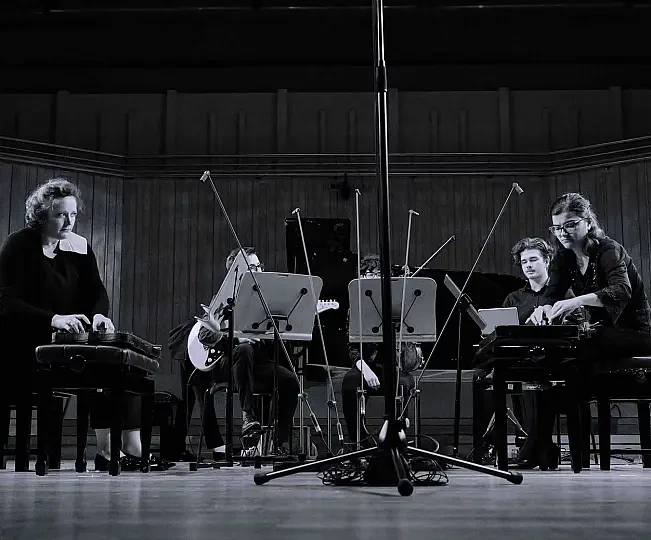Today's experimental composers are characterized by a high degree of individualism. While their primary aim isn't necessarily to stand out, in reality, they constitute an exceptionally diverse and eclectic community of classical composers. Their unique qualities contribute to an incredibly rich and diverse environment for art music in Denmark today. For many, it is a matter of entirely new perspectives on music.
Bára Gísladóttir
In the works of Bára Gísladóttir (b. 1989), melody is often downplayed, the emphasis instead on texture, dynamics, and unfiltered expression. In her pieces, time is as likely to move in circles as it is moving forwards towards a distinct goal, and her music comprises distortion-heavy sound masses, all-embracing beauty and a self-reflecting calm.
Mads Emil Dreyer
Mads Emil Dreyer’s (b. 1986) music exists as much in its own sure forms as in the listener’s individual response to them. He often sets up a dialogue between electroacoustic and acoustic entities, and his works are characterized by lightness and brightness, beauty and poetry.
Sandra Boss
The works of Sandra Boss (b. 1984) extrapolate from installation and performance to span a wide range of forms, media, and expressions. Her compositional voice is distinctly explorative with a strong interest in the hidden sonic potentials of instruments and technologies.
ÆTER is a piece for stringed instruments and EBows that seeks electronic and eerie sounding timbres in an acoustic setting. An EBow (short for electronic bow) is an electromagnetic battery driven device that constructs an inductive string driver feedback circuit, which forces the strings to vibrate without touching them physically.

Listen to an excerpt from ÆTER performed by Chaos String Quartet.
Mathias Monrad Møller
Danish/German Mathias Monrad Møller (b. 1988) works at the intersection of ideas and music as a way to try to capture the complexities of contemporary life. His compositions show a distinct interest in the conceptual staging of political, philosophical or poetic thoughts through music and are characterized by tensions between musical form and content, between ideas and their framing and between abstract sound as supertext and political reality as subtext.
Sophie Søs Meyer
Sophie Søs Meyer (b. 1991) works from a sense of being within a landscape of people, history, tradition, nature, spirits and sounds – a landscape where her music is already present before she intervenes. In her work, tradition plays an important role as an immediate sense of community and connectedness – an emotional fusion of multiple relations across time and space.
Kirstine Lindemann
The music of Kirstine Lindemann (b. 1987) seeks to parse the dynamic space between self and other. Through diverse formats – instrumental music, staged works incorporating movement and electronics, and installations – Lindemann investigates the complexities of interrelation: separation, entanglement, and where the boundaries that seem to divide us grow indistinct.
Matias Vestergård
"I always think of my music as melodies or polyphony, but it isn't fully satisfactory to me, just to write a beautiful melody," Matias Vestergård (b. 1989) tells about his approach to instrumental music. "I like it when the melody is constrained by some kind of obstacle that makes it particularly precious." Vestergård is a significant new voice on the new music scene.
Mette Nielsen
In Mette Nielsen's (b. 1985) music, the extreme details are paramount. She often works with what she calls the almost unison or imperfect unison – a state of friction that opens up a space where small differences and micro-tones are made audible. She has a fascinating gift for writing very beautifully without pathos.
Frej Wedlund
The works of Frej Wedlund (b. 1991) evoke a sense of ambiguity, exposedness and quiet tension, always seeking to explore the intimate in music and sound. His piece Crumblings deals with fragments, disparate materials, and drastic, form-wise shifts of the treatment of musical time
James Black
With James Black (b. 1990), you encounter a universe of real madness where ‘everything goes’. Where DIY video, hopeless choreographed performances, and accurately notated score music – among many other things – in a deliberately unsightly mix make up the work. The impossible is a deliberate dogma resulting in a unified expression, which is chaotic and almost gallows humorous, but where one senses a composer who ultimately has complete control over the final result
Greta Eacott
In her compositions, Greta Eacott (b. 1990) works with simplistic, structured forms in combination with elements of indeterminacy and a minimalistic approach to material that heightens the relationships between sound and silence, movement and stillness, texture and space.
Jeppe Ernst
With his radically reduced works, Jeppe Ernst (b. 1985) fundamentally questions our traditional ways of thinking about music. By removing all unnecessary layers of a work he seeks to illuminate its most essential idea, often eliminating one or more of the most basic musical parameters in the process – such as, for example, the audible sound.
Allan Gravgaard Madsen
Allan Gravgaard Madsen's (b. 1984) works are “poetically insistant” in their exploration of the tension between standstill and movement. The works consist of a micro world of sounds, sparse textures and limited musical material in which attention are drawn to the physical aspects of the classical instruments.
Martin Stauning
Martin Stauning's (b. 1982) works always have an immediate and sensuous quality that demonstrates his characteristic, lyrical expression. He composes sumptuous soundscapes and small details vibrating so intensely that time and place cease to exist.
